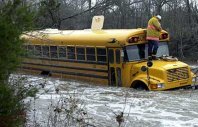Surviving Flash Floods Close to Home
Flash floods flow into low-lying areas - washes, rivers and streams.
It is caused by heavy rain associated with a thunderstorm, hurricane, or tropical storm. Flash floods are distinguished from a regular flood by a timescale less than six hours.
Causes
Rapid flooding occurs when the ground becomes saturated with water that has fallen too quickly to be absorbed. The runoff collects in low-lying areas and rapidly flows downhill. These floods most often occur in normally dry areas that have recently received precipitation, but may be seen anywhere downstream from the source of the precipitation - even dozens of miles from the source.
The United States National Weather Service gives the advice "Turn Around, Don't Drown" in reference to these floods; that is, it recommends that people get out of the area, rather than trying to cross it. Most people tend to underestimate the dangers.
Flash flooding is extremely dangerous because of their sudden nature. Being in a vehicle provides little to no protection against being swept away; it may make people overconfident and less likely to avoid the flood. More than half of the fatalities attributed to rapid floods are people swept away in vehicles when trying to cross flooded intersections. As little as two feet of water (60 cm) can be enough to carry away most SUV-sized vehicles.
The desert southwestern U.S. is especially dangerous for both hikers and vehicles from the sudden onslaught of water from isolated thunderstorms. These rains fill poorly-absorbent and often clay-like dry riverbeds. A moving flood will usually be headed by a debris pile that may have wood branches and/or logs. Deep slot canyons can be especially dangerous to hikers as they may be flooded by a storm that occurs on a mesa miles away, sweeping through the canyon, making it difficult to climb up and out of the way to avoid the flood.
What to do after a flood?
- Stay away from flood waters. The water may be contaminated by oil, gasoline or raw sewage. The water may also be electrically charged from underground or downed power lines.
- Stay away from moving water. Moving water only six inches deep can sweep you off your feet.
- Be aware of areas where flood waters have receded. Roads may have weakened and could collapse under the weight of a car.
- Stay away from downed power lines and report them to the power company.
- Stay away from disaster areas unless authorities ask for volunteers.
- Continue listening to a battery-powered radio for information about where to get assistance for housing, clothing and food.
- Consider your family's health and safety needs. Wash your hands frequently with soap and clean water if you come in contact with flood waters. Throw away food that has come in contact with flood waters. Listen for news reports to learn whether the community's water supply is safe to drink.
- Contact your insurance agent.
Ask your Flash Flood and Home Alarm Question HERE!
Flood Warning!! Let's Hope You Can Swim!!
Facts about Floods You Need to Know!
FEMA Flood Zones
From Flash Floods to Home Alarms to Alert You



